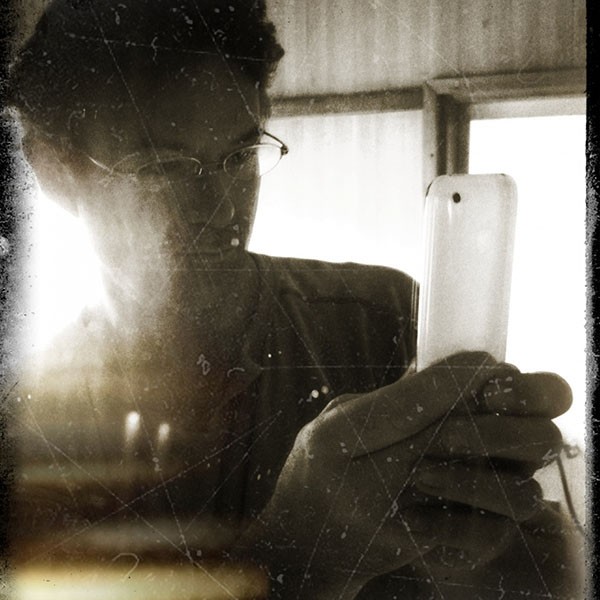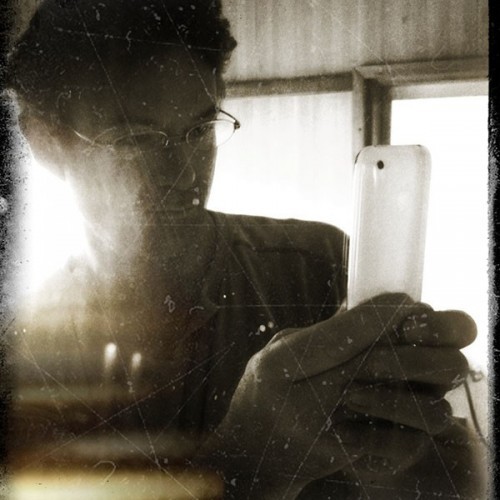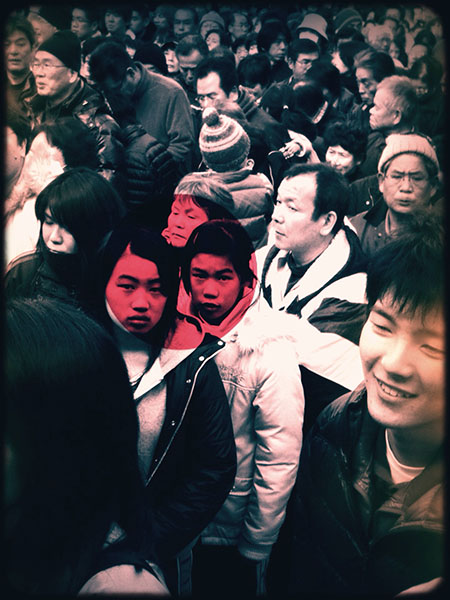However minimalistic his captions might seem, Japanese photographer’s Dave Weekes images of his native Tokushima City couldn’t be more graphic. As I’m staring at a selection of his work for the zillionth time on my computer, the titles come to explain once again the reasons I’ve initially admired his vision and keep returning to his work whenever in search of thought, emotion, or inspiration. “Woman Crossing On A Rainy Day As Seen From A Bus”, “Phone Booth”, “Window Washers” “Red Umbrella Before An Approaching Typhoon” “A Woman Rushing Past” “4 Stories” “Man On Overpass” “Alone On A Train” “Taxi” “Read” “Boy At Airport”.
This is the kind of photography that chronicles the subdued, the common and the mundane in ways only exercised by poets. For Dave Weekes is truly a poet at recording light, shadow or any other kind of electromagnetic radiation that’s associated with the medium of photography. Textured and layered to otherworldly proportions, his images transcend time and space, they somehow feel magical but at the same time very real.
With this prologue beginning to get in the way of allowing the artist to speak for himself, I therefore relieve you of my blabbering and pass on word to Dave, in this Life In LoFi interview that I was privileged to have been given.
Life In Lofi: Multi-layering is an element of great significance to your work. A single image contains a variety of points of perception, and focal points are often distorted beyond recognition. As a result, the final result springs out mystery, poetry, hope, solidarity and a whole array of emotions, open to individual interpretation. How do you explain your relationship with layers, textures and editing?
Dave Weekes: Most often I don’t have a clear idea of the final image in mind. I sometimes have a rough idea or a “feeling” that I’m after when I edit, sometimes no idea at all. It’s very much a journey of discovery. It’s a fun and therapeutic process to come to the end result. It brings to mind my favorite toy as a child, which was Lego. I think the slogan was “It’s a new toy everyday.” I get the same satisfaction and feeling of discovery creating images on my iPhone. I never really know what the final result will be.
LOFI: Did you set out from the beginning to create this kind of photography? Did you have a strict vision from early on? Or did it just happen that way?
DW: I originally bought my first iPhone, a 3GS for a few reasons. In no particular order; I love Apple products, I needed a phone, I like gadgets and I had seen on flickr someone who had used the Tilt Shift Generator app to create these cool miniature street scenes. I had wanted to buy a Lensbaby for my DSLR to experiment with tilt shift, but when I saw that I could do the same on an iPhone I was sold. From there I started experimenting and buying more and more apps. I found that I was finally able to realize some of the images/ideas I had in my mind. So really, my aesthetic has been there for ages. The iPhone, combined with the multitude of apps available allowed me to bring that out. It’s still progressing and I hope it never stops being a work in progress. There are still lots of concepts and ideas that I’m still not skilled enough to bring to reality. Time will tell.
LOFI: When or why did you decide to start taking pictures? Did someone draw you into it? And how has that relationship with photography evolved ever since?
DW: I started taking pictures in elementary school. I had an Instamatic camera, the type that used 110 film cartridges. In high school I took photography and even bought an old enlarger and printed black and whites in my basement. A few years after college I spent a year at a commercial photography school. I had every intention of making photography my career, I was particularly interested in stock photography. This was in the early 1990’s. Digital was on the horizon, but everyone shot chrome. I used Fuji Velvia, it cost about $1 a shot. I quickly ran out of money and as I started working to pay my rent and eat my dream and desire to do something with photography faded ever so slowly into the background. The iPhone changed all that!
LOFI: Tom Waits used to say that his whole approach to songwriting was a bad imitation of Louis Armstrong. Naturally, he was being moderate, and merely trying to underscore the creative interaction with his artistic heroes. Would you care to share with us your own influences? Mind you, these need not be necessarily restricted to photography.
DW: This is a good question. From an early age I was drawn to National Geographic Magazine. We had a subscription and I would basically wait by the mailbox each month for it to arrive. I poured over the images and I think that helped me develop my sense of composition and use of shape, shadow and light. Some photographers I discovered growing up include, Ernst Haas and Bill Brandt. As for other creatives, I am inspired by individuals who bring something fresh to an art form, while also remaining honest and true to themselves. Some notables; Brian Eno, David Bowie, Mark Mothersbaugh (of Devo fame), Woody Allen, Federico Garcia Lorca, the list goes on…
LOFI: How often do you work on your iPhoneography? Do you spend as much time on editing your photos as you do on going out there and capturing them?
DW: Since buying my 3GS in December of 2009, I’ve shot and posted images almost everyday. I did go through a period this summer and fall where I began to lose my focus and saw myself slowly slip away from the community. From the beginning of this year I’ve made it a bigger part of my life and have resumed posting almost everyday. As for time spent shooting versus editing, I’d say I spent more time shooting. I honestly edit my images fairly quickly.
LOFI: What has been the some of the challenges of using the iPhone as a camera?
DW: I think the biggest challenge for me has been the fixed focal length. When I shoot with my DSLR I use a zoom lens and I like to crop in camera. I know the iPhone has a digital zoom, but I never use it. It has forced me to become braver and get closer to my subjects.
LOFI: Do you feel your work gets the attention it deserves? Does it matter to you?
DW: I think I’ve been really lucky with the attention I’ve received. While I don’t have tens of thousands of followers on Instagram, I have been fortunate to have been in numerous mobile photography exhibits and recognized on most of the mobile photography blogs and awards. My work has also been published. Compared to where I was two and a half years ago I couldn’t be happier. Although a few more Instagram followers might be nice!
LOFI: What’s your preferable social network for uploading photos? To my knowledge, you post your work almost everywhere: Instagram, Flickr, Tumblr, EyeEm, Blurb Mobile. How would you compare them?
DW: I started with Flickr and still post there, but not as often. I’ve been with EyeEm since day one and they’ve shown me a lot of support (thanks guys!) Now I post everything to Instagram and select from there what I post to EyeEm and Flickr. I can see myself moving more to EyeEm in the future. The UI on their app has improved greatly and there is a very nice sense of community with them compared to IG.
LOFI: Impossibly enough, you haven’t anthologized a photo book of your work yet. Why so?
DW: Well, actually I have, I just didn’t tell anyone about it. I had a solo exhibit last fall in the public gallery space of the local power station. I wanted to have a book to be able to show more of my work. My plans were a bit too ambitious for the time that I had so I created a book from my Instagram feed using Blurb. I called it “Speedbook”. It took all of 5 minutes plus two weeks shipping. I let the Blurb photo gods do their thing. I will create a proper book sometime in the future. I have some ideas on how I want it to look, but don’t know yet how to achieve that.
LOFI: You’re already responsible for a vast amount of work, but can you bring yourself to choose a single image that never fails to make you go “wow”? That makes worth all your while?
DW: Yes, there is one image called “Crowds” that I shot last year at Ebisu Matsuri, a festival here in Tokushima to bring good luck to businesses and businesspeople.
LOFI: Do you ever have a creative block? If so, what do you do to break out of it? Do you look at the work of other iPhoneographers to be re-inspired?
DW: I often have creative blocks. So far I haven’t found a magic cure for that. Sometimes viewing other photography or movies will inspire me. Sometimes certain music will do the trick. I’ve learned not to force it. It’s kind of like a baby, it’ll come out when it’s ready!
LOFI: Do you also shoot with other cameras other than an iPhone?
DW: Yes I do. I use a Nikon D80. I would dearly love to shoot with a medium format digital camera, but at this point, they are a little out of my price range.
LOFI: For all the good mobile photography has done, do you feel it’s all become too easy now? That so many people can claim they are “photographers,” simply because they can post to Instagram?
DW: No, not really. I think it’s great that so many people are using Instagram and other social networking apps and sites. No matter how easy it becomes to do anything there will only ever be a small number who truly excel at any one particular thing.
LOFI: I’ve read somewhere that there’s only two kinds of photographers: farmers and hunters. I suppose that applies to the “chance or method” dilemma. Which category would you put yourself under?
DW: Hmm, I think I might be more of a hunter. I like to walk around and find interesting light, shadows, situations. I’m not very patient, so I need to be moving around.
LOFI: Apart from being a perfect camouflage for street photography, do you prefer shooting with your headphones on? Does the kind of music you listen to unconsciously determines your artistic outlet?
DW: I never shoot with headphones on. I find that really distracting. I like to be as much in the moment as I can.
LOFI: If I could give a title for this interview and for your photography in general, I’d name it “Extraordinary behind the ordinary”. Give us the 9 remaining rules for a “ten rules for street photography” short guide.
DW: Thank-you! I’m not really very good at following rules let alone creating them, but I’ll give it a shot.
In no particular order:
– Shoot, shoot and shoot more.
– Respect your fellow mobile photographers. (This is important)
– See light; shoot it. See shadow; shoot it.
– Find support. Not emotional, but hold that iPhone firmly, lean against something when shooting, images will be much sharper. (I break this rule all the time).
– Experiment
– Have fun.
– Don’t be shy.
– Clean your lens.
– Shoot for yourself, be honest!
LOFI: Is it my own impression that you have a great affection for the common people? Your photography usually chronicles the working class, the passer-by, the elders, the station to station commuters.
DW: I do have a great affection for all people. In my eyes everyone is equal. I don’t go out of my way to shoot a particular type of person, it probably just represents the demographic that makes up where I live.
..
~~~~
All photography in this post ©Dave Weekes. All rights reserved.













